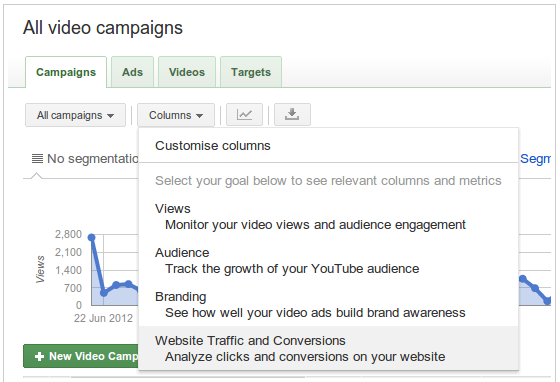Google Analytics recently went through a transformation, organizing once disjointed tools into intuitive categories. The tech-makeover gave webmasters easier access to essential information and restructured how inbound marketers looked at lead generation, nurturing and conversion on the web.
Last monght’s Google Analytics redesign showed that online reporting interfaces must remain dynamic and able to evolve as new functions come to fruition. This trend carried into AdWords, where Google recently revamped the interface for better video reporting.
The biggest search engine added three new measurement functions to the AdWords for video interface. The redesign made measurement goal-oriented and easier to compare cross-platform and cross-media outlets. New reach and frequency metrics like Average Impression Frequency and Average View Frequency have been added to the interface. These new measurement tools will show how many unique visitors have viewed an advertisement and the average number of times they’ve watched the clip. This will provide webmasters and marketers insight into how well their video content is doing on the web, making A/B testing a simpler practice online. To view the new metrics, navigate to Columns and then to Customize Columns. The new measurements should be categorized under the Performance section.
How are the column sets organized?
 The new column sets are grouped by marketing objective. In the Views column, users can see whether viewers watch more videos aftering engage with a paid video ad through metrics like follow-on views and unique viewers. Under Audience Development, webmasters can see how their video content drove consumers to watch and engage with additional content, and the Brand Awareness column shows the impact videos have had on the ‘net, highlighting viewer counts and average view frequencies. The last column – Traffic and Conversions – outlines website traffic, number of conversions, cost-per-conversion and conversion rate from ad viewers.
The new column sets are grouped by marketing objective. In the Views column, users can see whether viewers watch more videos aftering engage with a paid video ad through metrics like follow-on views and unique viewers. Under Audience Development, webmasters can see how their video content drove consumers to watch and engage with additional content, and the Brand Awareness column shows the impact videos have had on the ‘net, highlighting viewer counts and average view frequencies. The last column – Traffic and Conversions – outlines website traffic, number of conversions, cost-per-conversion and conversion rate from ad viewers.
AdWords for video also features a new geographic visualization interface. This shows campaign stats by location. Brands embarking on video marketing ventures must use Google AdWords in order to measure and refine their content creation strategies. These metrics and tools give users the ability to develop preliminary campaigns and see what works and what doesn’t work before making adjustments.




